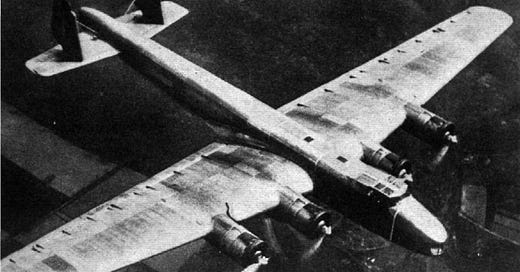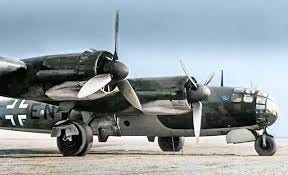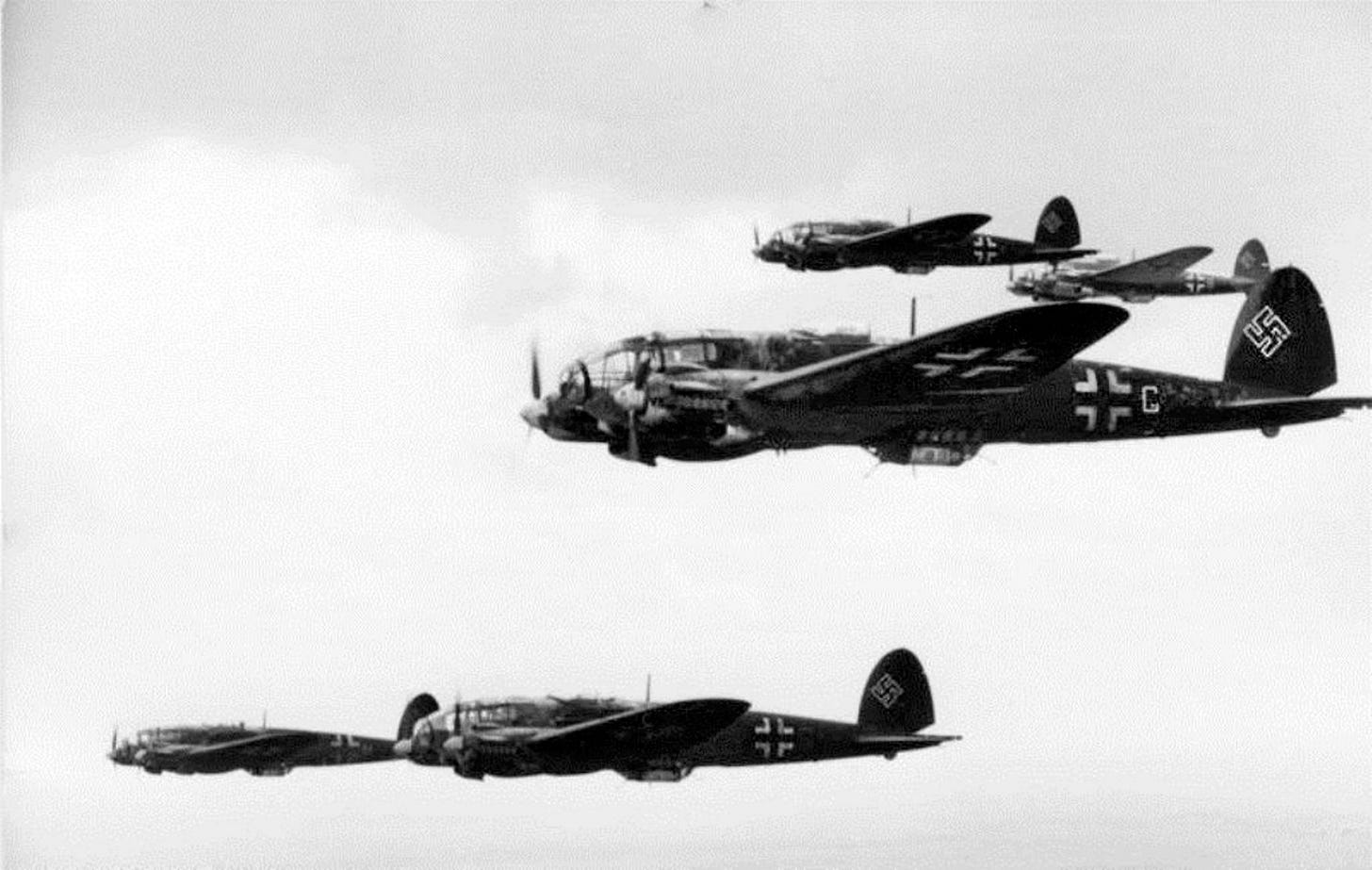I was doom scrolling YouTube shorts last night whilst laying in bed and caught some of a lecture on the reasons for Allied victory over the Axis and I caught one point that caused me to recall my undergraduate dissertation (The rise and Fall of the Luftwaffe and their role in Germany’s defeat) and thought I would just have a small vent.
Disclaimer - This is not a deep dive into German war economics, resource probing or Wehrmacht war aims and more of a thousand odd word response although I am happy to do a deeper dive if people want me to though it may take some time!
One of the many “What ifs” of the Second World War focuses on the Luftwaffe's lack of four engine bombers and had they had them could they have had a “strategic” airforce that could have defeated the RAF in 1940 and then carried the war into Russia? I remember reading a book called Eagle triumphant (I think - it was about 30 years ago) which wrote an alternate history of the Second World War where the Dornier Do. 19 is adapted as the main Luftwaffe bomber by 1940 and also that Herman Goring was killed during the Battle of Britain. Ultimately Germany still lost the war with an Atomic bomb on Berlin and Nurnberg but it also threw up some interesting problems with such a force, some of which I’m going to briefly examine.
Firstly let’s look at post First World War aerial theory. The Great War had shown that Terror bombing with Zeppelins was probably not as effective as the Kaiserliche-Marine had hoped and the German bombing campaign with aircraft was also nothing more than just pin pricks and an annoyance (despite tying down a lot of resources!) but the British had begun a strategic campaign with bombers into the Ruhr. The Italian theorist, Giulio Douhet, had theorised that aerial forces could win a war on their own and that “The bomber will always get through”. The air force, consisting of strategic bombers, could decimate any nation’s industrial, military and civilian centres unharmed by the enemy. Armies and Navies would become a thing of the past and unnecessary. There was a suggestion of a three wave bomber attack with different weapons that would decimate cities.
1.) Wave 1 drops conventional bombs that will destroy houses, burst gas mains, cause havoc and death.
2.) Wave 2 drops fire bombs which will ignite the broken gas mains and cause more damage and draw emergency forces en-masse.
3.) Wave 3 drops poison gas to kill as many of the civilians and first responders as possible.
As a sidebar there was a RAF theorist who suggested dropping a bomb full of cyanide or other poison into a nation’s reservoirs to kill off civilian populations - thankfully this was mooted.
Aerial theorists were very attracted to this sort of war with the horrors of trench warfare and long protracted land campaigns that had toppled empires still in their minds. If a relatively cheap air force could be constructed and knock an enemy out in a couple of weeks rather than a couple of years and for a fraction of the cost of human life then why the heck not?
The militaries of various European powers were somewhat more conservative and the belief in armies and warships continued - take Billy Mitchell’s take that aircraft could trump surface warships in combat and the way the USN tried to discredit his findings and bury the study only to be proved horrifically wrong at Pearl Harbour. In Britain the Navy would continue to work on battleships and cruisers and the army would still be the primary force for fighting abroad. The same was true in Germany as although by the 1930s Goring was Hitler’s number two and drew a lot of resources into his growing Luftwaffe the main commanders of the Wehrmacht’s high command were Heer and Navy conservatives who had fought in the First World War and saw the need to carry on in the usual style towards victory, just better than last time.
There is also a problem with investment. In the 1930s every European nation was somewhat poor following the 1929 crash and the economic shockwaves that followed. Building militaries is not cheap, especially when you have other economic needs that require investment within the nation. Why build for a war that won’t happen? For the Navy there were also restrictions on warship sizes but that’s another post for another day.
It is worth remembering that in the mid 1930s the RAF were looking to move from the Hawker Hart biplane and its variants, with similar light bombers for “tactical” army support and longer range twin engine bombers which could carry out a “strategic” bomber campaign. This results in the Fairey Battle and Bristol Blenheim for the former and Hampden and Wellingtons for the latter. There were moves in the late 1930s for a larger aircraft and the B.12/36 high speed long range strategic bomber which resulted in the Short Stirling which began to come into production four years later in 1940.
The Luftwaffe also looked at four engine bombers championed by General Walter Wever who believed that a “Ural Bomber” could supplement the main Kampfgeschwader’s twin-engine bombers and could penetrate as far as the Russian Urals. The Junkers Ju. 89 and Dornier Do. 19 were the main proposals and underwent development.
After Wever’s death in an aircrash the Luftwaffe went quickly in a different way with Udet being a supporter of dive-bombers and Jeschonnek preferring to continue what they had started as the Ural bomber program had some serious drawbacks and this is the crux of the matter.
Firstly the resources.
Germany was massively short of resources like rubber and metals and so the number of aircraft would be limited if they went down the Ural bomber route. I think the ratio worked out as something like five fighters = three bombers = one Ural bomber so the Luftwaffe would be making itself smaller than it could be. Goring is also reported to have said;
“The Fuhrer will never ask how big our bombers are, only how many we have.”
Germany never planned on fighting a long war, they knew that they could not stand to hold out with the resources they had available (including petrol) so what they needed to do was smash an enemy quickly. It is feasible that Douhet’s suggestion might work but the Military traditionalists suggested a hybrid using Guderian’s “Achtung Panzer!” as a blueprint. The Luftwaffe would be used as a flying artillery to support the tank spear heads which could penetrate deep into enemy territory causing disarray and smash opposition quickly. Terror raids on civilian centres would only occur after the enemy’s air force had been neutralised and as part of a campaign against the enemy’s armed forces. Civilians would take to the roads in fear and block transport routes. The threat of the Luftwaffe could also be used as a diplomatic tool as it was in Denmark during the invasion of April 1940 and newsreels showing waves of German bombers was enough to make this point, a smaller force of four engine bombers would have not been as effective as the Public, like the Fuhrer, would look at the number of aircraft not the amount of engines.
As the conflict progressed the Luftwaffe was mainly used as flying artillery and the strong Army presence in OKW as well as Hitler’s understanding of air power, meant that they were pigeonholed very heavily into this role and not used for a proper strategic force. Germany didn’t need a four engine bomber to gain the local superiority that the Wehrmacht required for a Schwerpunkt (their point of attack) and Stukas and twin engine aircraft would be more than sufficient to support a thrust so why develop a four engine heavy? For the British a larger aircraft made sense so that they could target German industry with heavier bomb loads and attack German centres at a greater range whilst using their already existing twin engine bombers to support military operations abroad such as in Egypt and Libya.
With the situation changing the idea of a Ural and indeed Amerika bomber was proposed again, resulting in the Heinkel He. 177 four engine (though in two nacelles) bomber. This aircraft was built in limited numbers and it was too late to have an impact. Had the Germans managed to divert vital resources to the development of such a force they would have been robbing Junkers Ju. 88 production as well as the much needed Bf. 109 and Fw. 190 production in much the same way that the Jet fighters did.
Looking at losses as well - the USAAF lost 60 Flying fortresses in the Second Schweinfurt raid of 14th October 1943 to fighters and flak. This was 600 pilots and aircrew killed or captured in a day and it was labelled Black Thursday and caused a rethink to deep probes into German territory in the daylight. The US had a vast pool of manpower and could, eventually recover from these losses but the Germans could not if they had a similar incident. For each Do.19 also had a crew of ten and so for each one lost it would be ten much needed men lost. To paraphrase Generalfeldmarschall Kesselring on the Battle of Britain;
Every time a British fighter pilot is shot down, barring injury and the provision of a new aeroplane he can be in action the next day. For every one of my aircraft lost over enemy territory whether killed, injured or untouched the pilots (and crews) are a complete loss.
Flying deep over England or Russia would have seen these men lost and killed for little to no gain. The British had proved in December 1939 that a formation of unescorted bombers could not always get through with the battle over Heligoland Bight and the Luftwaffe had seen it for themselves over the skies of Britain. Having a force of Ural bombers operating deep over the enemy, unescorted, would be a complete waste of men and resources.
So in short the Germans could have built a four-engine bomber force, the designs were good to go, but they, in their view, did not need them for the kind of war they wanted to fight and with the resources they had available.







Goring comment about the number of Bombers and the Fuhrer makes me wonder how much the drug addiction was effecting the decisions. Hitler with a amphetamine addiction and Goring with a morphine addiction.
Great stuff, background information that could fuel five different alt history stories.